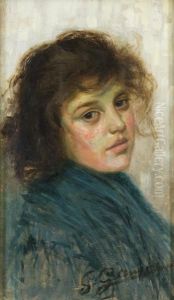Giacomo Gemmi Paintings
Giacomo Gemmi was an Italian painter and sculptor, born in 1871 in the small town of Volterra, Italy. His early life was marked by a profound interest in the arts, influenced significantly by the rich cultural heritage of his homeland. Tuscany, with its remarkable history of art and architecture, provided a fertile ground for Gemmi's artistic inclinations. He embarked on his artistic journey at a young age, demonstrating a keen eye for detail and a profound understanding of the human form.
Gemmi's education in art began in the local schools of Volterra, but his talent soon necessitated further study in more prestigious institutions. He moved to Florence, a city renowned for its artistic legacy, where he studied under several prominent artists of the time. His work, primarily focusing on painting and sculpture, drew inspiration from the Renaissance masters, yet he infused his creations with a modern sensibility that was distinctively his own.
Throughout his career, Giacomo Gemmi exhibited a remarkable versatility, working across different mediums with equal proficiency. His sculptures, characterized by their lifelike precision and emotional depth, earned him considerable acclaim. Similarly, his paintings, which often explored themes of nature and human emotion, were celebrated for their vibrant coloration and dynamic compositions.
Despite his contributions to the Italian art scene, Gemmi remained relatively unknown outside of his home country for much of his life. It was only in the later years of his career and posthumously that his work began to receive the international recognition it deserved. Today, Giacomo Gemmi is celebrated as one of the notable figures of Italian art from the late 19th and early 20th centuries.
Giacomo Gemmi passed away in 1950, leaving behind a legacy of artistic achievement that continues to inspire and captivate audiences. His works are preserved in several museums and collections across Italy, serving as a testament to his skill and vision. Gemmi's life and art remain a subject of study for art historians and a source of enjoyment for art lovers around the world.

